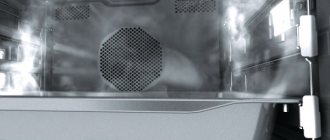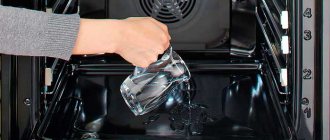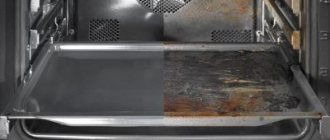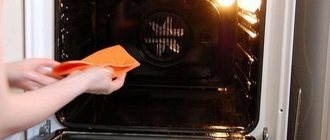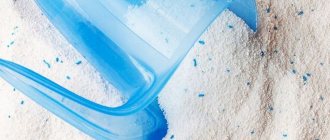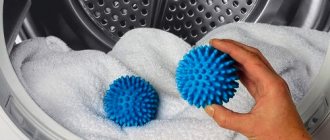Many delicious dishes are prepared in the spirit of the cupboard. But after cooking is finished, dirt and grease appear on the walls. It is not always possible to remove dirt from the internal surfaces of the oven with detergents; sometimes it becomes necessary to use a stiff brush. Then there is a risk of damaging the enamel coating of the oven. Among the modern methods of cleaning the oven, one can highlight hydrolysis - removing contaminants with steam.
What is hydrolysis oven cleaning and the principle of its operation will be discussed in the article.
The principle of hydrolysis purification
Hydrolysis purification is based on the chemical reaction of hydrolysis (decomposition). Water interacts with substances that break down, resulting in the formation of new compounds.
The essence of cleaning is as follows:
- — Pour water into a special baking tray, close the oven and heat it to 90 degrees;
- — When the oven heats up, steam begins to emerge from the water, which softens dirt and grease.
- — After the oven has cooled, the softened fat that has drained to the bottom must be removed manually.
Important: the more often hydrolysis cleaning is carried out, the higher its effectiveness will be. It is recommended to use this cleaning method after each use of the oven. In this case, it will be possible to avoid old dirt and stains, which are much more difficult to remove.
Ovens with a steam cleaning method have an internal surface covered with special enamel that is resistant to food acids. The protective coating does not allow particles of fat and dirt to penetrate inside the oven.
Important: when purchasing, it is better to choose ovens with enamel that prevents the accumulation of fat; in the future it will be easier to carry out hydrolysis cleaning.
After hydrolysis cleaning, you need to use a damp cloth, so this function is not automatic. It is recommended to clean the oven after each cooking so that future cleaning takes as little time and effort as possible.
Features of using electric ovens
Listed above are several universal rules that can significantly reduce the degree of contamination, but electric has its own additional features.
- Never place food containers on the bottom or bottom of the oven. In this place the temperature is maximum, the fat that gets on the surface burns very strongly. In addition, heating elements are not designed to work in confined spaces. They require constant air flow for cooling, otherwise the devices will fail prematurely.
The tray with the dish must be placed in the electric oven so that there is a small distance between the top shelf and the bottom, this is necessary so that the food is baked evenly
- Do not allow fat to come into contact with the surface of the heating elements; they have a very high temperature. Under such conditions, the fat ignites, and during combustion, superheated particles fly in different directions at high speed. They stick very tightly to the oven surfaces and make the cleaning process much more difficult.
Cooking in the oven using foil and a sleeve
- The fan must be constantly on during operation of electrical equipment - a large amount of grease is removed with air flows, which reduces the degree of contamination of surfaces.
Electric ovens with convection function provide forced air circulation
As practice shows, electric ovens need to be cleaned of dirt much more often than gas ovens. This is explained by the fact that these devices have more complex automation and precise electrical fittings; they can only work under certain conditions. The appearance of a thick layer of dirt can cause short circuits and complete breakdown of the oven.
And the last recommendation for all types of ovens is to carefully study the instructions for use and unconditionally follow the manufacturers’ recommendations. Each advice is given only after thorough laboratory and field testing, all of which have been repeatedly confirmed in practice.
How to hydrolyze oven cleaning
Unlike pyrolytic cleaning, hydrolysis does not require significant energy expenditure and is easy to perform.
Cleaning process:
- — You need to remove the baking sheet and guides from the oven;
- — Pour water into the special container at the bottom of the oven. If there is no special recess, you need to take a shallow, wide container, fill it with liquid and place it on the grill;
- — You can add a special gel to the water to enhance the cleaning effect. You may need up to one and a half liters of liquid; for each model, the volume of water is taken according to the instructions;
- — When you turn on the cleaning mode, the oven begins to heat up to 50 - 90 degrees, depending on the manufacturer and model of the oven. Under the influence of temperature, water turns into steam and begins to soften fat and dirt from the internal surfaces of the oven;
- — After cleaning is complete, clean the inside of the oven with a cloth.
If the oven has not been cleaned for a long time, dirt or grease has hardened in it, and cleaning has not led to the expected result, you will need to additionally use a sponge and cleaning agent.
Pyrolysis, hydrolysis or catalysis – which is better?
Comparison table of oven cleaning types
Each type of cleaning has its own advantages and disadvantages.
When making a choice in favor of one technology or another, you should consider:
- how often the device will be used;
- what price segment is acceptable;
- what should be the quality of the materials used;
- Is it important to fully automate the process or is minor manual cleaning allowed?
- what is the power of the electrical wiring;
- Do you have a powerful hood at home?
The pyrolysis model is convenient if it is possible to purchase expensive equipment , a wire with a power of at least 600 W is installed, and the kitchen is equipped with a powerful hood.
Hydrolysis does not require large amounts of electricity , eliminating the possibility of burns. The method is quite simple and cost-effective, but requires additional manual work to remove any remaining burnt fat.
If saving money is a priority, then the best option would be a gas stove with a catalytic type of removal of old contaminants, although this type of equipment is less functional than electric ovens. Catalysis is suitable for frequent use of the stove and will greatly facilitate the process of removing old grease and stains.
Hydrolysis cleaning functions in new ovens
In addition to standard hydrolysis cleaning, additional functions for ovens are popular.
The “Cleaning” function is found in many oven models. Cleaning is carried out using special sprays that generate steam.
The technology works on the following principle:
- — The oven must be heated to a temperature of 90 degrees;
- — After 15 minutes, the oven door opens, and you need to quickly treat the internal surfaces with a special spray, then close the oven door again;
- - After the oven has cooled completely, you need to clean away traces of spray, liquid and split fat. It may take approximately 15 minutes.
Modern ovens have another cleaning function, “Aqua Clean”. It differs from the “Cleaning” function in that cleaning occurs at a lower temperature. You need to take 500 ml of water, fill the baking tray, the oven will warm up to a temperature of 50 degrees, cleaning takes about 30 minutes. After automatic shutdown, you can open the oven door and clean the inside.
Important: premium ovens have hydrolysis programs with the ability to select intensity and time
Helpful information
Useful information on implementing the hydrolysis oven cleaning method:
after the dirt gets wet, you should not use abrasives or hard sponges to remove them, they can damage the inner walls of the oven, which will cause the fat to stick to them even faster, and it will be difficult to remove;- if, in addition to fatty deposits, an unpleasant odor comes from the oven, for example, after a burnt dish, you can add a small amount of vinegar to the water;
- Under the influence of steam, old contaminants practically do not come off, so it is recommended to carry out the procedure constantly.
Advantages and disadvantages of the hydrolysis cleaning method
When choosing an oven with hydrolysis cleaning, you need to familiarize yourself with the advantages and disadvantages.
Main advantages:
- — Regular use of cleaning makes it easy to remove dirt in the future;
- — Energy savings;
- — Cleaning using the “Cleaning” function is carried out at an average temperature of 90 degrees and takes only 15 minutes. A special steam spray allows you to remove difficult stains.
- — Cleaning with the “Aqua Clean” function is carried out at a low temperature of 50 degrees, its duration is approximately 30 minutes.
- — The function does not significantly affect the final cost of the oven.
Disadvantages of hydrolysis cleaning:
- — Steam does not break down old stains on the inner surfaces of the oven. As the stains dry, the structure of the stains changes and to remove them, you need to clean them several times. You may need to use a metal sponge to clean it.
- — After cleaning, you need to wait until the oven has completely cooled down, and then clean the split fat and dirt manually.
- — Before you start cleaning, you need to remove the racks, skewer, and baking sheets from the oven. Additional components will need to be washed by hand.
Important: the hydrolysis method makes the cleaning process easier, but does not cope with old dirt and stains.
Review of other modern systems
Modern oven models also provide other cleaning systems: catalytic and pyrolytic.
Pyrolytic cleaning system
The essence of pyrolysis is to burn contaminants at temperatures up to 500 degrees. This system is considered the most effective, since during the procedure all internal surfaces of the oven are cleaned, and after its completion you only need to wipe off the soot. Disadvantages include high cost, unpleasant odor when burning deposits, and high energy costs.
Catalytic purification
In catalytic ovens, the walls have a special porous, rough coating containing chemical oxidizers that decompose fats into soot and water. Accumulated fat disintegrates every time the oven is used, self-cleaning occurs during cooking.
Is it profitable to buy an oven with a pyrolytic type of cleaning?
Many buyers are interested in what is the difference between pyrolytic and catalytic oven cleaning.
The benefits of purchasing an oven with pyrolysis technology raise some doubts
Pyrolysis is the breakdown of substances due to exposure to high temperatures. Leftover food burns completely, turning into ash and soot.
The benefits of purchasing an oven with pyrolysis technology raise some doubts. Such models have the highest cost compared to other types of food residue removal. On average, the price category is 2 times higher than the cost of other middle-class ovens.
This is due to the quality of the material used to decorate the interior walls. The doors have additional protection against burns.
This type of cleaning is present only in electrical units. Pyrolysis is not economically viable due to the high level of energy consumption. When installing, it is important to consider that the power cable voltage must be 6000 V.
The exception is ovens with “6th sense” technology. Its essence is that the device reacts to the concentration of carbon dioxide, which is released during combustion. When its level begins to decrease, the process stops.
Pyrolysis has its economic advantages. Such ovens serve for a long time without breaking down and do not require frequent replacement of expensive parts. Most of these models are equipped with a self-cleaning function, which significantly reduces the costs required to purchase detergent.
How to use?
How to use an oven with pyrolysis function:
- Remove the kitchen utensils that are in it, take out the baking sheets and racks.
- Select the required mode on the control panel based on the degree of contamination, press the “Start” button. When the temperature rises to 300 degrees, the door will lock to prevent burns. It will be possible to open it again when the cleaning process is completed: the temperature begins to drop and reaches 200 degrees.
- After cooling, remove the resulting ash with a brush, then wipe the surface with a soft cloth.
When using the oven daily, pyrolysis is carried out at least once every 7 days.
Modern models are equipped with additional functions that will help make working with the device easier:
- The presence of a filter that automatically starts the cleaning process after 100 hours of operation.
- Built-in sensor system that tells the housewife that it is time to remove dirt.
- Step-by-step instructions for cleaning the oven, which are displayed on the digital display.
Evolution of pyrolysis and energy consumption
Ovens with pyrolysis appeared quite recently, but during this time they have evolved.
In early models, 3 types of cleaning were programmed:
| Mode | Purpose | Working hours |
| Minimum | Used in cases of light contamination | 2 hours 15 minutes |
| Ordinary | Medium difficulty | 2 hours 40 minutes |
| Maximum | If there is a thick or old layer of fat | 3 hours 15 minutes |
Read more ► How to light the oven in a gas stove Hephaestus, Greta, Indesit and others
Gradually, almost every manufacturer of household appliances began to produce models based on the needs of customers and use a catalytic filter, which allows them to quickly burn large contaminants and save energy consumption.
Some manufacturers produce ovens in which food is burned in several levels. This allows you to avoid heating the device to maximum temperatures.
About the quality of ovens with pyrolytic cleaning
Pyrolysis ovens are the highest quality appliances.
This is explained by the fact that high combustion temperatures require appropriate quality material. For the manufacture of such devices, only the highest quality steel is used. The walls and bottom are covered with special enamel that can withstand high temperatures.
The door glass is completely safe. This is achieved thanks to the presence of 3 or 4 tempered glasses. The door locks during operation. The case is equipped with a cooling system, but it is important to consider that the temperature of the device can reach 100 degrees or higher.
Important! The presence of children or pets near the appliance while cleaning the oven is unacceptable!
There is a safety system inside the unit in case of fire. To do this, sensors are installed that record temperature and carbon monoxide concentrations.
Some brands of ovens have filters that are located on the convector grill. Their task is to protect the fan from contamination.
The oven's durable enamel can be cleaned with regular non-abrasive cleaners. This will help save energy costs.
Unpleasant odor during pyrolysis
Among the few disadvantages of this type of cleaning, an unpleasant odor should be noted. This is due to the fact that all residues burn to the ground at a temperature of 500 degrees, and soot is formed.
During cleaning, be sure to turn on the hood and open the kitchen window wide. To solve this issue, you can attach a pipe to the hole in the back wall of the device and lead it into the ventilation system.
If you have a catalytic filter, this problem should not arise. It is designed to operate during the entire service life of the device. Automatic filter cleaning occurs after every 100 hours of operation.
To reduce odor levels, cleaning should be done at least once a week if the unit is used frequently.
Results
Features of use include:
- — the surface of the door and the bottom of the oven are not covered with a special coating, so they must be cleaned manually;
- — Panels with special enamel are recommended to be replaced every 4-5 years.
When deciding which cleaning is better: hydrolysis or catalytic, or choosing a pyrolytic cleaning method, you need to study the features of each type, and also take into account all the pros and cons. The hydrolysis method is the most common and accessible, which is why many users choose it.
The cleaning method is simple, reliable and makes cleaning economical. Hydrolysis cleaning makes it easier and faster to get rid of grease and dirt, but is inferior to other types of built-in cleaning in terms of efficiency. This method has been used for a long time not only in ovens, but also in microwaves.
Hydrolysis or pyrolytic system?
Another easy way to clean an oven is pyrolysis. It is believed that it is more perfect than hydrolysis and catalytic ones. It has the following advantages:
- Dirt removal occurs due to the action of high temperatures without the use of additional means;
- Manual removal of dirt residues is ensured by its complete combustion.
But the disadvantages are also important:
- Products with the introduction of this system are much more expensive than analogues;
- Connecting high temperatures involves high power consumption;
- Strong heat can damage nearby furniture, so the oven must be insulated.
Video: pyrolytic system
Thus, it is worth noting that of all the methods offered by manufacturers, the hydrolysis method of washing can be considered the most profitable. On the other hand, it is less effective compared to other methods.
